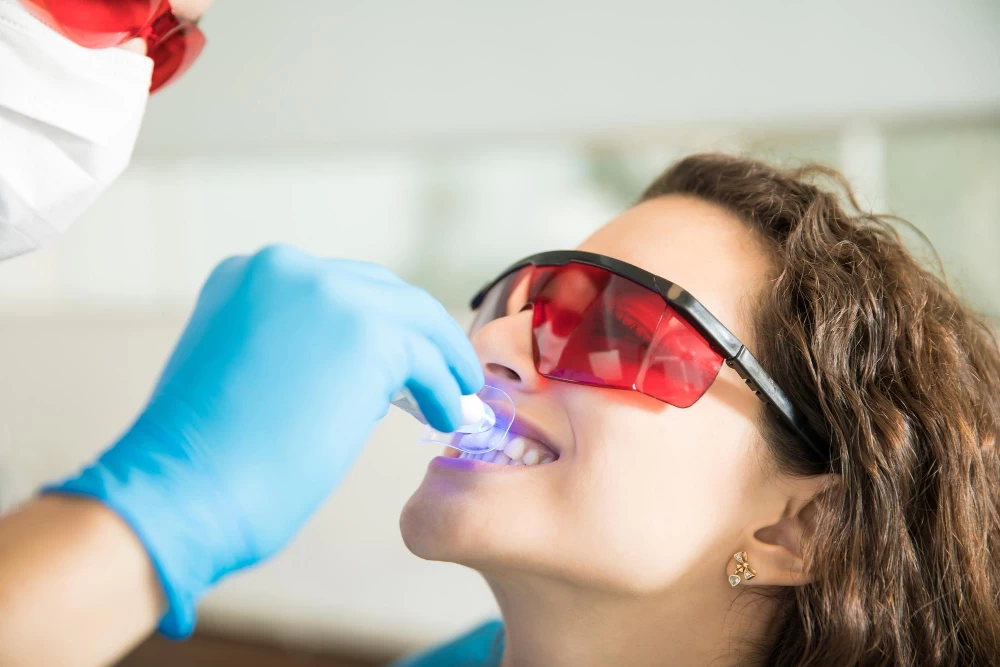
Tooth Polishing
- Tooth Polishing
- What is the Tooth Polishing Process?
- What are the Stages of the Tooth Polishing Process?
- At What Intervals Should Teeth Polishing Be Performed?
- Are There Any Harms or Risks of Tooth Polishing?
- At What Age Range Should Teeth Polishing Be Applied?
What is the Tooth Polishing Process?
Tooth polishing is a dental cleaning procedure to remove plaque, stains and other deposits on the teeth. Tooth polishing is usually done during a routine dental cleaning, but can also be done as a separate process to improve the appearance of teeth.
During the teeth polishing process, the dentist uses a special dental polishing tool. This tool is used to apply a special paste called polishing paste to the teeth. Parlatma macunu genellikle ince bir aşındırıcı içerir ve yüzey lekelerini ve plak oluşumunu gidermeye yardımcı olur. Dental polisaj makinesi yüksek hızda dönerken, polisaj patı dişlere yavaş ve hafif bir basınçla uygulanır.
Tooth polishing can help teeth appear cleaner and brighter. It can also help remove surface stains that cause teeth to appear yellow or discolored. However, it is not a substitute for regular dental care, such as brushing and flossing, and should only be done by a qualified dentist.
What are the Stages of the Tooth Polishing Process?
Tooth polishing is a tooth cleaning procedure that includes the following steps:
- First of all, a dental cleaning is done to clean your teeth. During dental cleaning, the dentist will remove plaque and tartar deposits from the surface of your teeth.
- The special polishing tool to be used for tooth polishing is prepared. The polishing tool is used in a controlled manner by the dentist.
- A special paste called polishing paste is applied to the teeth. Polishing paste usually contains a fine abrasive and helps remove surface stains and plaque buildup.
- The polishing tool is applied to the teeth with slow and gentle pressure. In this way, plaque and stains on the surface of the teeth are removed.
- All surfaces of the teeth are coated with a polishing process. The dentist completes the polishing process by taking care of all surfaces of each tooth.
- After the polishing process is complete, it is important to rinse your teeth thoroughly to remove all polishing paste and other residues left in the mouth.
Tooth polishing helps your teeth look cleaner and brighter, while also helping to keep your teeth healthy.
At What Intervals Should Teeth Polishing Be Performed?
Tooth polishing is usually done in conjunction with regular tooth cleaning and is recommended by dentists every six months. However, it may need to be done more frequently in people with excessive tartar or plaque accumulation on the teeth or in cases where tooth stains are evident.
Also, teeth polishing can be done when you want to make your teeth look brighter and whiter. In this case, you can get advice on how often it should be done by talking to your dentist.
Are There Any Harms or Risks of Tooth Polishing?
Tooth polishing is generally considered a safe procedure and does not involve any risk or harm. However, in some cases, some risks and side effects may occur during the teeth polishing process.
- Erosion of the enamel layer on the tooth surfaces: The abrasive pastes used during the tooth polishing process can erode the enamel layer. Therefore, the dentist should not apply too much pressure or a harsh polish.
- Tooth sensitivity: Temporary sensitivity may occur in your teeth after tooth polishing. This sensitivity usually goes away within a few days.
- Grinding: During the teeth polishing process, when too much pressure is applied to your teeth, this can cause a grinding sensation or clenching problems.
- Permanent damage to tooth enamel: Permanent damage to tooth enamel can occur if too much pressure or abrasives are used during the tooth polishing process. However, this situation is quite rare.
- Gum bleeding: After tooth polishing, sensitivity and bleeding may occur in the gums. However, this condition is usually temporary.
Most of the above risks are temporary and rare, and dental polishing is generally considered a safe procedure. However, it is recommended that you talk to your dentist about the risks and benefits and plan a dental polishing procedure that suits you.
At What Age Range Should Teeth Polishing Be Applied?
Tooth polishing can be applied at any age. Tartar, plaque and stains on teeth can occur at any age, and tooth polishing can help solve these problems.
However, it is more appropriate to apply tooth polishing after puberty. During this period, the maturation of the tooth enamel and the shaping of the teeth are completed. Also, dentists often take special precautions to protect teeth prior to polishing, as teeth may be more sensitive at a young age.
Also, dentists perform a more careful examination before polishing, as tooth sensitivity and gum problems may be more common in older people. In this way, teeth can be kept healthier in older people.
As a result, tooth polishing can be applied at any age, but dentists generally recommend it to be done after puberty. You can make a special plan for you by talking to your dentist.


